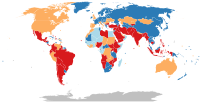
Photo from wikipedia
The emergence of COVID-19 as a global pandemic in early 2020 has led to pervasive changes in the social and occupational behavior of scientists and physician-scientists. Perhaps expectedly, there has… Click to show full abstract
The emergence of COVID-19 as a global pandemic in early 2020 has led to pervasive changes in the social and occupational behavior of scientists and physician-scientists. Perhaps expectedly, there has been a surge in biological, epidemiological, and clinical publications pertaining to COVID-19 in the worldwide scientific community. However, many researchers have had limited or no access to their regular place of work and are under (at least partial) mandatory or voluntary stay-at-home orders. For some, this may have elicited a shift of focus from front-end study components, such as laboratory or clinical projects, to back-end study components, such as data analysis and manuscript preparation, which could elicit a greater amount of journal submissions. This has prompted an enquiry into the submission trends of Pediatric Research during the COVID-19 period. The total monthly submissions from 2017 to 2020 were compared by year to examine the overall trends in submission activity, while articles relating to COVID-19 were identified in order to determine their relative influence on the submissions in 2020. Monthly manuscript submissions were obtained with permission from the editorial office of Pediatric Research for the period of February 2017 through July 2020. Revised submissions were not included in this analysis. Manuscripts regarding COVID-19 were isolated from the ScholarOne database by searching for articles submitted in 2020 containing at least one of the following terms in its title: “COVID”, “CORONA”, and “SARS”. R (Version 3.6.2) was used for all statistical analyses and graphing. The total monthly submission data including COVIDrelated articles were not normally distributed and were thus log-10 transformed to meet the assumption of normality. Monthly data excluding COVID-related articles were also not normally distributed and were natural-log transformed to meet the assumption of normality. Gaussian distribution was assessed using a Wilks-Shapiro test for normality. Homogeneity of variance between years was confirmed using a Levene’s Test. Assessment of differences in mean submissions were averaged across the COVID-impacted period (February-July). One-way analysis of variance (ANOVA) was used to evaluate the differences in transformed averages between years (2017-2020). Post-hoc Tukey HSD tests were used to assess post-hoc comparisons between years. The results of this analysis are shown in Figure 1. On average, there were 69 submissions to Pediatric Research in 2017, 78 in 2018, 90 in 2019, and 125 in 2020 during the 6-month study period. This led to greater average submissions during 2020 as compared to 2017-19 (p < 0.01 for all years), notably an 80.1% increase from 2017 to 2020, a 60.1% increase from 2018 to 2020, and a 39.2% increase from 2019 to 2020. Similar to 2020, the average submissions in 2019 were also greater than those in 2017 (p= 0.01), consistent with the general upward trend in submissions by year. As of July 2020, there have been a total of 82 COVID-related articles submitted to Pediatric Research, with the highest being in April (22) and the lowest in February (1, Fig. 1). However, after excluding COVID-related articles, the average submissions in 2020 remained greater than those in 2017 and 2018 (p < 0.01), with the exception being only a trend towards a significant increase from 2019 to 2020 (p= 0.06). Our results seem to suggest that, although COVID-19 submissions account for a notable proportion of Pediatric Research submissions since the onset of the pandemic, they do not fully explain the significantly higher number of journal submissions during 2020. The perpetuation of the 2020 increase after exclusion of COVID articles lends support to this interpretation. When considering the application of these results to occupational behavior during COVID-19, it appears many scientists may be spending more time writing and preparing manuscripts than before the pandemic began. However, some of the 2020 increase may be explained by the yearly rise in submissions to Pediatric Research, although the average increase from 2019 to 2020 (35) was much higher than between previous years. In summary, we suggest that:
Journal Title: Pediatric Research
Year Published: 2020
Link to full text (if available)
Share on Social Media: Sign Up to like & get
recommendations!